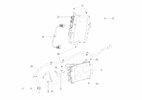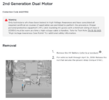Cheburashka
Active Member
Just had this happen on my 2016.5 75D.
How hard is it to get to the junction box for the fuse and the ptc heater?
How hard is it to get to the junction box for the fuse and the ptc heater?
You can install our site as a web app on your iOS device by utilizing the Add to Home Screen feature in Safari. Please see this thread for more details on this.
Note: This feature may not be available in some browsers.
Yeah, I was expecting something that looked more like that. But I thought maybe they changed to a newer fuse after the 2016.5 refresh. Cheburashka - Sounds like you should know as you just replaced it. I assume that is in the frunk area after teardown. Any advice on videos to watch? Anyone know the Tesla part number for the FWP-40A14Fa?...This is the correct fuse: Tesla Model S Fuse FWP-40A14Fa FWP-40A14F 40Amps 700V for DC - DC converter | eBay
No. Anyone know? What runs on 40a that isn't in the High Voltage group?...Did they told where it’s suited on the car?
Clever temporary solution with the hand warmers!I heard a pop and shortly …no heat. Happened to have a dozen hand warmers in the car. Read that they absorb moisture, so I put them in the windshield and drove a few hundred miles in below freezing temperatures. I am definitely adding this fuse to the car’s winter safety kit…as soon as I figure out what and where it is on my ‘17 75D.
Service center doesn’t stock heater cores so I figured I’d get another fuse and see if I can get by for a bit. They gave me this…
View attachment 892319
Anybody think that is right?
Yeah, I was expecting something that looked more like that. But I thought maybe they changed to a newer fuse after the 2016.5 refresh. Cheburashka - Sounds like you should know as you just replaced it. I assume that is in the frunk area after teardown. Any advice on videos to watch? Anyone know the Tesla part number for the FWP-40A14Fa?
No. Anyone know? What runs on 40a that isn't in the High Voltage group?
Clever temporary solution with the hand warmers!
That's a 12v fuse. You need a fuse rated for 700v and it's not easily accessible like the 12v fuses. You need to be careful when working around 400v as it can be lethal. I applaud those that fixed it via DIY, but I'd be happy to let the Tesla techs handle this one. The downside is for the oldest cars, Tesla service replaces the DC-DC inverter when it may only need the internal fuse replaced.
It’s actually 58V fuse, here is description. What I have found on this sheet it might be in the fuse box in the frunk, see photo:That's a 12v fuse.
Air compressor, condensor fansNo. Anyone know? What runs on 40a that isn't in the High Voltage group?
Aways 100% safe when 12V removed and fireman's loop without any doubt? I wouldn't bet my own life on it. Contactors can weld etc. so I would advise always to measure to make sure you are at below 10V before touching any bare HV wires. It takes literally a few minutes to measure with relatively simple equipment.I don't think it's that dangerous.
Do shutdown, remove the 12V battery lead + firemans loop beside it. It will isolate and de-energize the FJB completely. Literally no way for power to flow into it.
Tried to get a FWP-40A14Fa from the service center. One of the techs assured me they don’t carry that part. Said they do carry this…

That's how I understand Tesla does it anyway - they specifically said they had to drop the HV battery to reach the fuses on my '17 MS. That's where I stopped considering this a DIY project.So if the professor is correct that HV battery must be removed to get to the front junction block, then its defn not DIY
That's how I understand Tesla does it anyway - they specifically said they had to drop the HV battery to reach the fuses on my '17 MS. That's where I stopped considering this a DIY project.
But, I've heard rumors as I recall (maybe previously here) that it might be technically possible to reach it without dropping the HV - but it wasn't something I wanted to try. Think I posted my Tesla repair invoice earlier here.

That seems to be the magic question. By Friday I will have access to both fuses, but I’m not setup to drop the HV pack.…remove/replacing the whole FJB I don't know if that is possible without removing the HV battery
Your SIBA fuse or FWP fuse are both fine, sometimes Tesla start using other brands bc of cost reductionAlso, my service center’s fuse shows up in this post, I assume that is the high voltage junction box.


